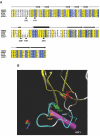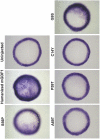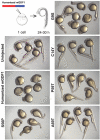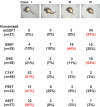Loss-of-function mutations in growth differentiation factor-1 (GDF1) are associated with congenital heart defects in humans
- PMID: 17924340
- PMCID: PMC2265655
- DOI: 10.1086/522890
Loss-of-function mutations in growth differentiation factor-1 (GDF1) are associated with congenital heart defects in humans
Abstract
Congenital heart defects (CHDs) are among the most common birth defects in humans (incidence 8-10 per 1,000 live births). Although their etiology is often poorly understood, most are considered to arise from multifactorial influences, including environmental and genetic components, as well as from less common syndromic forms. We hypothesized that disturbances in left-right patterning could contribute to the pathogenesis of selected cardiac defects by interfering with the extrinsic cues leading to the proper looping and vessel remodeling of the normally asymmetrically developed heart and vessels. Here, we show that heterozygous loss-of-function mutations in the human GDF1 gene contribute to cardiac defects ranging from tetralogy of Fallot to transposition of the great arteries and that decreased TGF- beta signaling provides a framework for understanding their pathogenesis. These findings implicate perturbations of the TGF- beta signaling pathway in the causation of a major subclass of human CHDs.
Figures





Similar articles
-
Reduced NODAL signaling strength via mutation of several pathway members including FOXH1 is linked to human heart defects and holoprosencephaly.Am J Hum Genet. 2008 Jul;83(1):18-29. doi: 10.1016/j.ajhg.2008.05.012. Epub 2008 Jun 5. Am J Hum Genet. 2008. PMID: 18538293 Free PMC article.
-
Association of functional variant in GDF1 promoter with risk of congenital heart disease and its regulation by Nkx2.5.Clin Sci (Lond). 2019 Jun 17;133(12):1281-1295. doi: 10.1042/CS20181024. Print 2019 Jun 28. Clin Sci (Lond). 2019. PMID: 31171573
-
Functional study of DAND5 variant in patients with Congenital Heart Disease and laterality defects.BMC Med Genet. 2017 Jul 24;18(1):77. doi: 10.1186/s12881-017-0444-1. BMC Med Genet. 2017. PMID: 28738792 Free PMC article.
-
Role of the vascular endothelial growth factor isoforms in retinal angiogenesis and DiGeorge syndrome.Verh K Acad Geneeskd Belg. 2005;67(4):229-76. Verh K Acad Geneeskd Belg. 2005. PMID: 16334858 Review.
-
Using Zebrafish to Analyze the Genetic and Environmental Etiologies of Congenital Heart Defects.Adv Exp Med Biol. 2020;1236:189-223. doi: 10.1007/978-981-15-2389-2_8. Adv Exp Med Biol. 2020. PMID: 32304074 Review.
Cited by
-
Failed Progenitor Specification Underlies the Cardiopharyngeal Phenotypes in a Zebrafish Model of 22q11.2 Deletion Syndrome.Cell Rep. 2018 Jul 31;24(5):1342-1354.e5. doi: 10.1016/j.celrep.2018.06.117. Cell Rep. 2018. PMID: 30067987 Free PMC article.
-
Establishment of a Dihydrofolate Reductase Gene Knock-In Zebrafish Strain to Aid Preliminary Analysis of Congenital Heart Disease Mechanisms.Front Cardiovasc Med. 2021 Dec 15;8:763851. doi: 10.3389/fcvm.2021.763851. eCollection 2021. Front Cardiovasc Med. 2021. PMID: 34977180 Free PMC article.
-
Association of GDF1 rs4808863 with fetal congenital heart defects: a case-control study.BMJ Open. 2015 Dec 11;5(12):e009352. doi: 10.1136/bmjopen-2015-009352. BMJ Open. 2015. PMID: 26656983 Free PMC article.
-
A variant in the carboxyl-terminus of connexin 40 alters GAP junctions and increases risk for tetralogy of Fallot.Eur J Hum Genet. 2013 Jan;21(1):69-75. doi: 10.1038/ejhg.2012.109. Epub 2012 Jun 20. Eur J Hum Genet. 2013. PMID: 22713807 Free PMC article.
-
Oxidative stress is responsible for maternal diabetes-impaired transforming growth factor beta signaling in the developing mouse heart.Am J Obstet Gynecol. 2015 May;212(5):650.e1-11. doi: 10.1016/j.ajog.2015.01.014. Epub 2015 Jan 13. Am J Obstet Gynecol. 2015. PMID: 25595579 Free PMC article.
References
Web Resources
-
- GenBank, http://www.ncbi.nlm.nih.gov/Genbank/ (for human GDF1 [accession number NM_001492])
-
- Online Mendelian Inheritance in Man (OMIM), http://www.ncbi.nlm.nih.gov/Omim/ (for NODAL, LEFTY1, LEFTY2, PITX2, GDF1, SMAD2, SMAD3, SMAD4, FOXH1, TGA, and CFC1)
-
- PDB, http://www.pdb.org/ (for 1LX5)
References
-
- Zhu L, Belmont JW, Ware SM (2006) Genetics of human heterotaxias. Eur J Hum Genet 14:17–25 - PubMed
Publication types
MeSH terms
Substances
Associated data
- Actions
Grants and funding
LinkOut - more resources
Full Text Sources
Medical
Molecular Biology Databases

